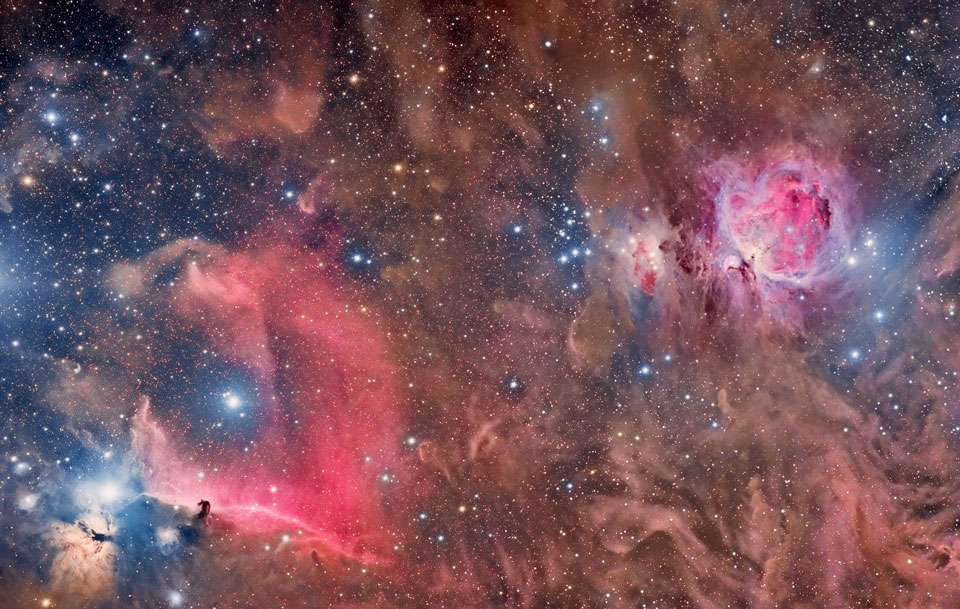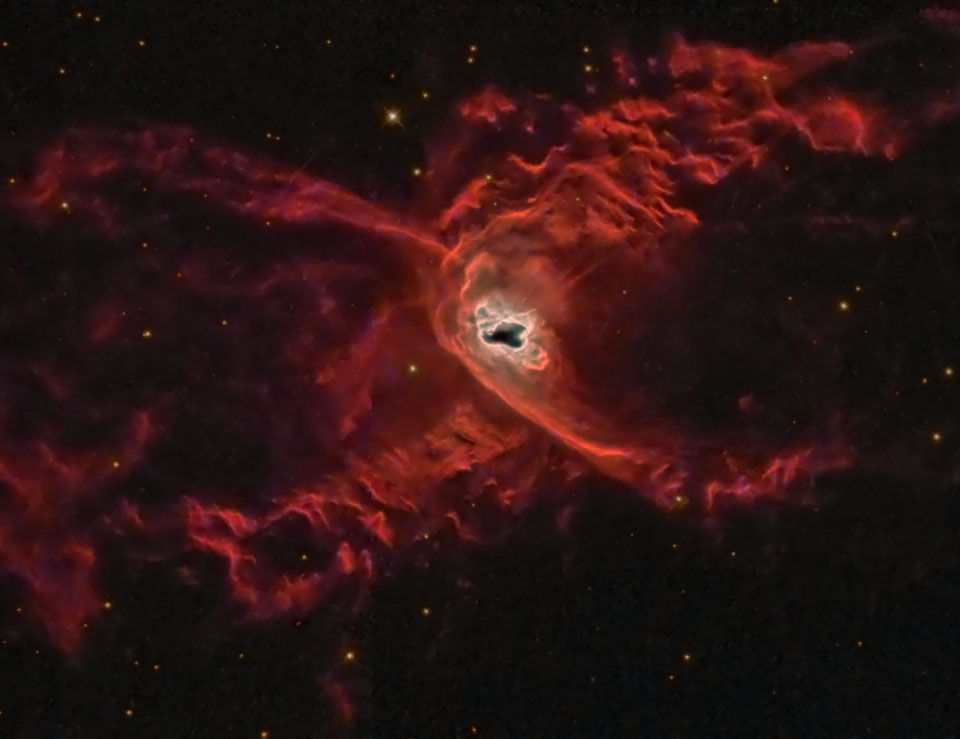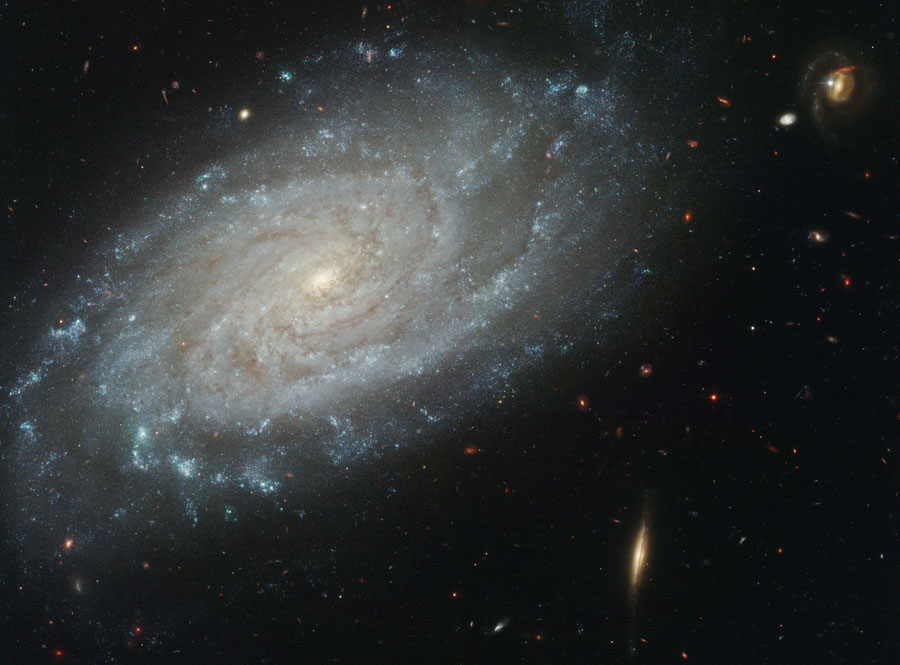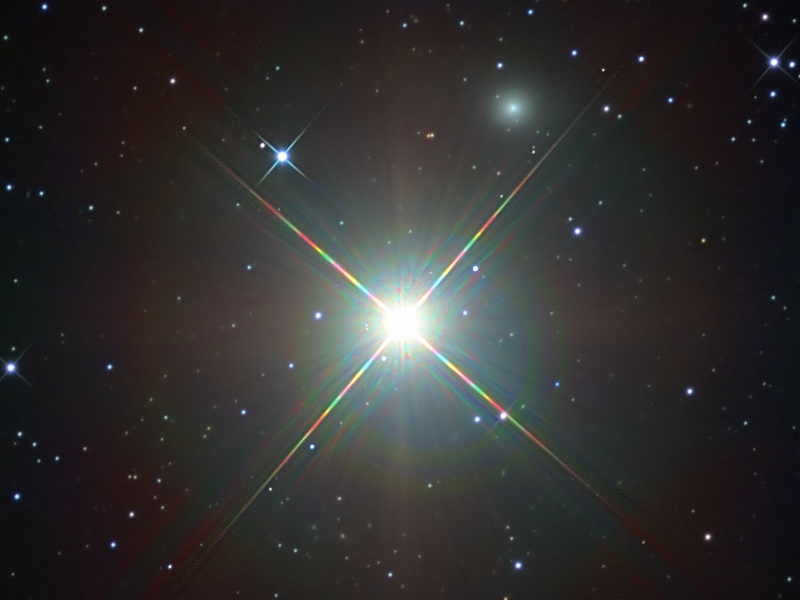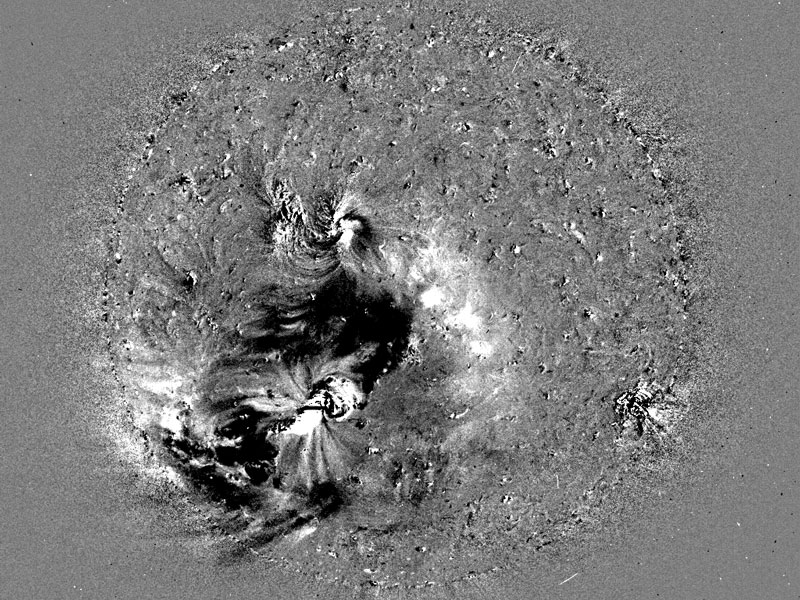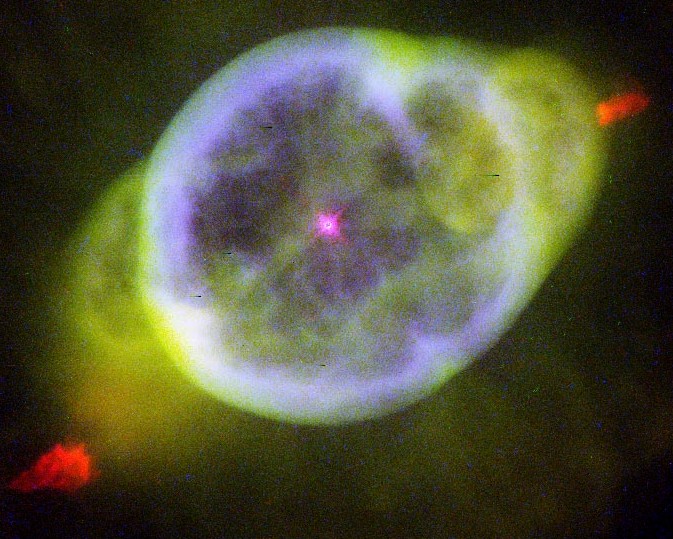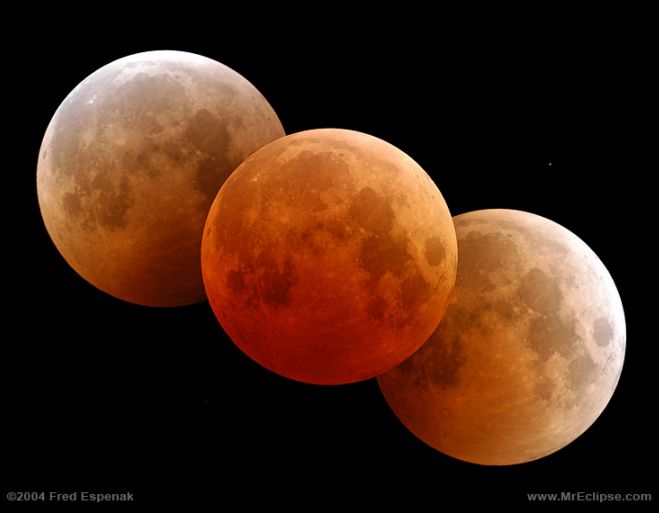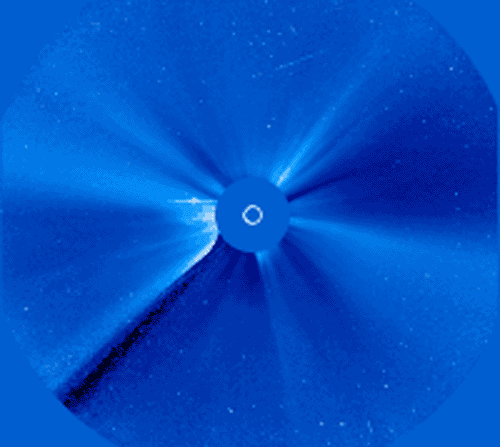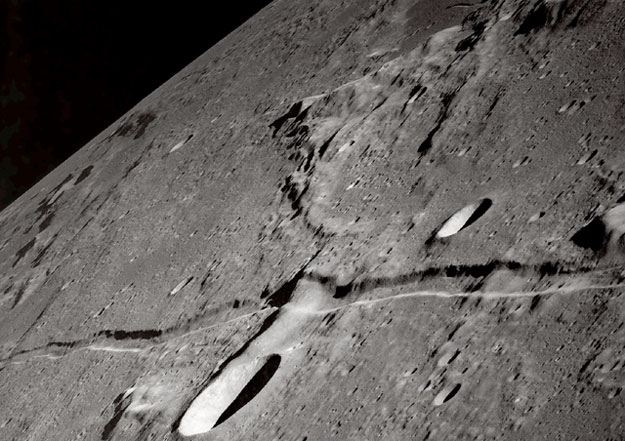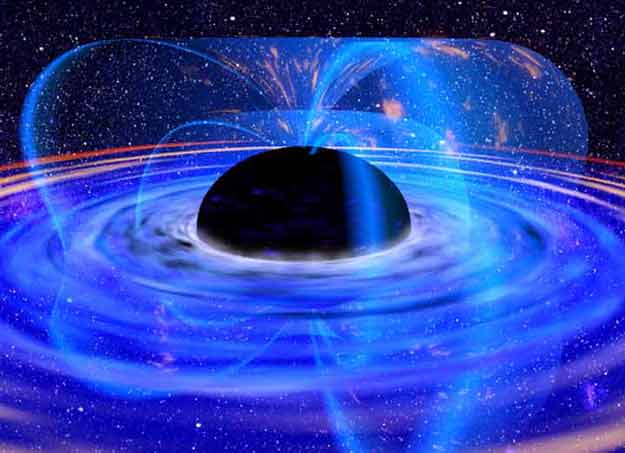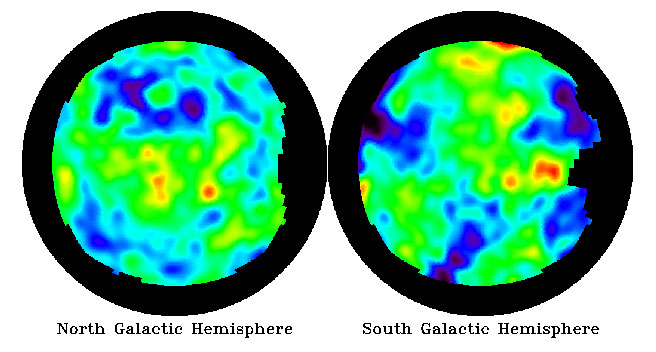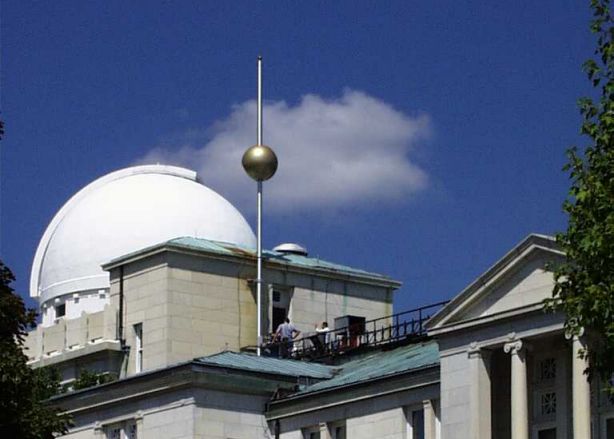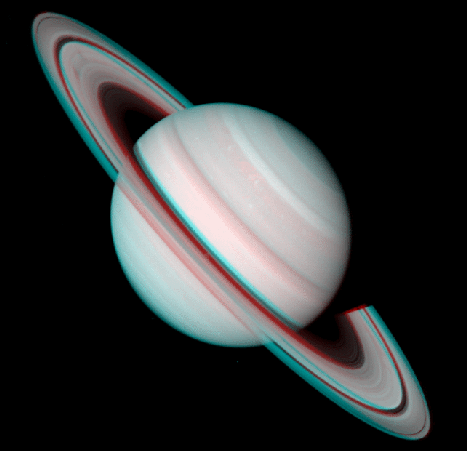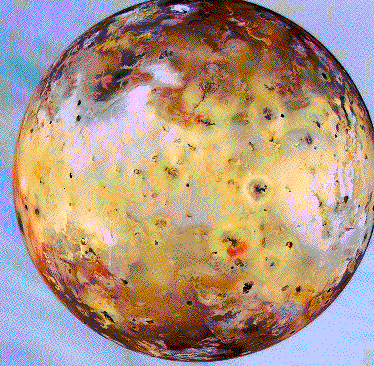| << Previous | Index | Next >> |
2014 Sometimes your eclipse viewing goes bad in an interesting way. While watching and photographing last Thursday's partial solar eclipse, a popular astronomy blogger suffered through long periods of clouds blocking the Sun. Unexpectedly, however, a nearby cloud began to show a rare effect: iridescence. Frequently part of a more familiar solar corona effect, iridescence is the diffraction of sunlight around a thin screen of nearly uniformly-sized water droplets. Different colors of the sunlight become deflected by slightly different angles and so come to the observer from slightly different directions. This display, featured here, was quite bright and exhibited an unusually broad range of colors. On the right, the contrails of an airplane are also visible.
2013 The dark Horsehead Nebula and the glowing Orion Nebula are contrasting cosmic vistas. Adrift 1,500 light-years away in one of the night sky's most recognizable constellations, they appear in opposite corners of the above stunning mosaic. The familiar Horsehead nebula appears as a dark cloud, a small silhouette notched against the long red glow at the lower left. Alnitak is the easternmost star in Orion's belt and is seen as the brightest star to the left of the Horsehead. Below Alnitak is the Flame Nebula, with clouds of bright emission and dramatic dark dust lanes. The magnificent emission region, the Orion Nebula (aka M42), lies at the upper right. Immediately to its left is a prominent reflection nebula sometimes called the Running Man. Pervasive tendrils of glowing hydrogen gas are easily traced throughout the region.
2012 Oh what a tangled web a planetary nebula can weave. The Red Spider Planetary Nebula shows the complex structure that can result when a normal star ejects its outer gases and becomes a white dwarf star. Officially tagged NGC 6537, this two-lobed symmetric planetary nebula houses one of the hottest white dwarfs ever observed, probably as part of a binary star system. Internal winds emanating from the central stars, visible in the center, have been measured in excess of 1000 kilometers per second. These winds expand the nebula, flow along the nebula's walls, and cause waves of hot gas and dust to collide. Atoms caught in these colliding shocks radiate light shown in the above representative-color picture by the Hubble Space Telescope. The Red Spider Nebula lies toward the constellation of the Archer (Sagittarius). It's distance is not well known but has been estimated by some to be about 4,000 light-years.
2011 Is this what our own Milky Way Galaxy looks like from far away? Similar in size and grand design to our home Galaxy (although without the central bar), spiral galaxy NGC 3370 lies about 100 million light-years away toward the constellation of the Lion (Leo). Recorded above in exquisite detail by the Hubble Space Telescope's Advanced Camera for Surveys, the big, beautiful face-on spiral is not only photogenic, but has proven sharp enough to study individual stars known as Cepheids. These pulsating stars have been used to accurately determine NGC 3370's distance. NGC 3370 was chosen for this study because in 1994 the spiral galaxy was also home to a well studied stellar explosion -- a Type Ia supernova. Combining the known distance to this standard candle supernova, based on the Cepheid measurements, with observations of supernovas at even greater distances, has helped to reveal the size and expansion rate of the entire Universe itself.
2010 Look closely at this surreal nightscape. In the dreamlike scene, star trails arc over an old ship run aground on a beach near Gytheio, Peloponnesus in southern Greece. Could that be the captain's ghost haunting the beach, gazing forlornly at the decaying wreck, hovering over starlight reflected in still water? Actually, the ephemeral shape is the photographer. Instead of a single long exposure to record the motion of the stars as the Earth rotates on its axis, the picture is composed of 90 consecutive images, each exposure 90 seconds long. Digitally stacking the individual exposures then reconstructs the star trails. It also creates a ghostly, semi-transparent figure of the photographer who was captured standing on the beach in only one of the exposures.
2009 An unusual triangle of light is visible this time of year just before dawn, in the northern hemisphere. Once considered a false dawn, this triangle of light is actually Zodiacal Light, light reflected from interplanetary dust particles. The bright reflecting triangle is clearly visible on the right of the above image taken from Laguna Verde near Valparaíso, Chile in late July. The band of our Milky Way Galaxy on the left mirrors the zodiacal band. Zodiacal dust orbits the Sun predominantly in the same plane as the planets: the ecliptic. Zodiacal light is so bright in the north this time of year because the dust band is oriented nearly vertical at sunrise, so that the thick air near the horizon does not block out relatively bright reflecting dust. Zodiacal light is also bright for people in Earth's northern hemisphere in March and April just after sunset. In the southern hemisphere, zodiacal light is most notable after sunset in late summer, and brightest before sunrise in late spring.
2008 As far as ghosts go, Mirach's Ghost isn't really that scary. In fact, Mirach's Ghost is just a faint, fuzzy galaxy, well known to astronomers, that happens to be seen nearly along the line-of-sight to Mirach, a bright star. Centered in this star field, Mirach is also called Beta Andromedae. About 200 light-years distant, Mirach is a red giant star, cooler than the Sun but much larger and so intrinsically much brighter than our parent star. In most telescopic views, glare and diffraction spikes tend to hide things that lie near Mirach and make the faint, fuzzy galaxy look like a ghostly internal reflection of the almost overwhelming starlight. Still, appearing in this sharp image just above and to the right, Mirach's Ghost is cataloged as galaxy NGC 404 and is estimated to be some 10 million light-years away.
2007 What's happened to Comet Holmes? A normally docile comet discovered over 100 years ago, Comet 17P/Holmes suddenly became nearly one million times brighter last week, possibly over just a few hours. In astronomical terms, the comet brightened from magnitude 17, only visible through a good telescope, to magnitude 3, becoming visible with the unaided eye. Comet Holmes had already passed its closest to the Sun in 2007 May outside the orbit of Mars and was heading back out near Jupiter's orbit when the outburst occurred. The comet's sudden brightening is likely due to some sort of sunlight-reflecting outgassing event, possibly related to ice melting over a gas-filled cavern, or possibly even a partial breakup of the comet's nucleus. Pictured above through a small telescope last Thursday, Comet Holmes appeared as a fuzzy yellow spot, significantly larger in angular size than Earth-atmosphere blurred distant stars. Although Comet Holmes' orbit will place it in northern hemisphere skies for the next two years, whether it will best be viewed through a telescope or sunglasses remains unknown.
2006 Our Earth endures bursts of particles from the Sun. On 1997 April 7, at 10 am (EDT), ground monitors of the SOHO spacecraft, which continually monitors the Sun, noticed a weak spot in the solar corona was buckling again, this time letting loose a large, explosive Coronal Mass Ejection (CME). Almost simultaneously, NASA's WIND spacecraft began detecting bursts of radio waves from electrons involved in this magnetic storm. Supersonic waves rippled though the solar corona as a puff of high energy gas shot out into the Solar System. The above image shows two photographs of the Sun taken about 15 minutes apart and subtracted, highlighting the explosion. CME's are not unusual. The CME gas had little lasting effect on the Earth, but likely created fleeting, if not picturesque, Earth auroras.
2005 After a star like the Sun completes fusion in its core, it throws off its outer layers in a brief, beautiful cosmic display called a planetary nebula. NGC 3242 is such a planetary nebula, with the stellar remnant white dwarf star visible at the center. This nebula is sometimes called The Ghost of Jupiter for its faint, but similar appearance to our solar system's ruling gas giant planet. NGC 3242 is light-years across however, and much farther away than the measly 40 light-minutes distance to Jupiter. In fact, while watching this ghostly nebula expand over time, astronomers have estimated the distance to NGC 3242 to be about 1,400 light-years. The red FLIERs visible near the edges of the nebula are still a bit mysterious, though.
2004 Some thought of baseball and some thought of Halloween during October 27th's widely viewed total lunar eclipse. Sliding through Earth's shadow, the Moon turned haunting shades of red and orange during the eclipse's total phase. The reddish hues are caused by sunlight scattered and refracted by the atmosphere into the Earth's otherwise dark central shadow region. Enjoying the show from Dunkirk, Maryland, USA, astronomer Fred Espenak recorded the images used in this composite photo. The picture shows the Moon at the beginning (right), middle (center) and end (left) of totality which lasted about 81 minutes. Though lunar eclipses can occur twice a year, this eclipse is perhaps remarkable for being the first total lunar eclipse to occur during a World Series baseball game.
2003 Yesterday, our Sun produced one of the most powerful solar flares in recorded history. Seen across the electromagnetic spectrum, the Sun briefly became over 100 times brighter in X-rays than normal. Over the next few days, as energetic particles emitted from these regions strike the Earth, satellite communications might be affected and auroras might develop. The flare and resulting CME, emitted from giant sunspot group 10486, was captured above as it happened by the by the LASCO instrument aboard the Sun-orbiting SOHO satellite. The disk of the Sun is covered to accentuate surrounding areas. The time-lapse movie shows the tremendous explosion in frames separated in real time by about 30 minutes each. The frames appear progressively noisier as protons from the flare begin to strike the detector. The SOHO satellite has been put in a temporary safe mode to avoid damage from the solar particle storm.
2002 What could cause a long indentation on the Moon? First discovered over 200 years ago with a small telescope, rilles (rhymes with pills) appear all over the Moon. Three types of rilles are now recognized: sinuous rilles, which have many meandering curves, arcuate rilles which form sweeping arcs, and straight rilles, like Ariadaeus Rille pictured above. Long rilles such as Ariadaeus Rille extend for hundreds of kilometers. Sinuous rilles are now thought to be remnants of ancient lava flows, but the origins of arcuate and linear rilles are still a topic of research. The above linear rille was photographed by the Apollo 10 crew in 1969 during their historic approach to only 14-kilometers above the lunar surface. Two months later, Apollo 11, incorporating much knowledge gained from Apollo 10, landed on the Moon.
2001 What makes the core of galaxy MCG-6-30-15 so bright? Some astronomers believe the answer is a massive spinning black hole. If so, this would be the first observational indication that it is possible to make a black hole act like a battery -- and tap into its rotational energy. MCG-6-30-15 is a distant galaxy that has recently been observed with the orbiting XMM-Newton satellite in X-ray light. These observations show the galaxy's nucleus not only to be very bright but also to show evidence that much of the light is climbing out of a deep gravitational well. A spinning black hole could explain both effects. A strong magnetic field could be the mediator transferring rotational energy from the black hole to the surrounding gas. Pictured above is an artist's illustration of a black hole surrounded by an accretion disk. For clarity, the illustration does not include distorting gravitational lens effects.
2000 These spots are the oldest, most distant structures known. They are seen on the above two images of the microwave sky, north and south of our galaxy's equator, based on four-year's worth of data from NASA's COsmic Background Explorer (COBE) satellite (1989-1993). The spots represent temperature variations in the early universe. As our universe expanded and cooled, conglomerations of mass formed. These COBE images confirmed that only a million years after the big-bang - which occurred roughly 15 billion years ago - parts of the universe were visibly hotter than other parts. By studying the size and distribution of the spots found on the microwave background, astronomers hope to learn what matter and processes caused the spots to form - and hence determine the composition, density, and future of our Universe. Results from recent measurements of the cosmic microwave background are consistent with a universe stranger than previously thought, possibly filled with unexpected forms of dark matter and dark energy. A more detailed analysis might result after NASA's Microwave Anisotropy Probe is launched in 2001.
1999 In the nineteenth century, dropping a time ball from a prominent location was a practical way of communicating the time to the surrounding country side and ships at sea. Initiating a fledgling time service for the United States, the U.S. Naval Observatory dropped a time ball at precisely noon every day begining in 1845. At the end of the twentieth century, in commemoration of this traditional method of disseminating time, the U.S. Naval Observatory has installed this ceremonial time ball atop its main building in Washington D.C. Dropping this time ball - at midnight Eastern Standard Time on New Year's Eve - will be the local culmination of a "round-the-world time ball drop" marking the beginning of the year 2000 and the beginning of the Third Millennium in 2001. Meanwhile, don't forget ... this year, in most of the U.S. Daylight Time ends at 2:00 am on Sunday, October 31.
1998 Rehearsing for his historic flight on February 20, 1962, Mercury program astronaut John H. Glenn Jr. works in a cramped training capsule preparing for a few hours' voyage through space. Dubbed Friendship 7, his own snug spacecraft was launched by an Atlas rocket and carried Glenn three times around planet Earth at an altitude of about 120 miles, returning him safely to a "splashdown" in the Atlantic Ocean. The first American in orbit, Senator Glenn's remarkable return to space will be 36 years later as a payload specialist on the Space Shuttle Discovery mission STS-95. Discovery is a roomier craft which will carry a crew of 7 and an array of scientific payloads, such as the International Extreme Ultraviolet Hitchhiker. Scheduled for launch today at 2:00 PM Eastern Time, Discovery will orbit at an altitude of 320 miles and land after 8 days at Kennedy Space Center's shuttle landing facility. Godspeed the crew of STS-95 !
1997 Get out your red/blue glasses and launch yourself into this stereo picture of Saturn! The picture is actually composed from two images recorded weeks apart by the Voyager 2 spacecraft during its visit to the Saturnian System in August of 1981. Traveling at about 35,000 miles per hour, the spacecraft's changing viewpoint from one image to the next produced this exaggerated but pleasing stereo effect. Saturn is the second largest planet in the Solar System, after Jupiter. Its spectacular ring system is so wide that it would span the space between the Earth and Moon. Although they look solid here, Saturn's Rings consist of individually orbiting bits of ice and rock ranging in size from grains of sand to barn-sized boulders.
1996 Io is a colorful place. The closest large moon of Jupiter, Io is the most volcanic moon in the Solar System with its surface being completely buried in volcanic lava every few thousand years. The black and red material corresponds to the most recent volcanic eruptions and is probably no more than a few years old. This image by the automated spacecraft Galileo highlights the side of Io that always faces away from Jupiter. In this image released last week, picture colors have been adjusted to enhance contrast, but are based on real composite infrared, green and violet-light images.
1995 When massive stars explode they create large radioactive blast clouds which expand into interstellar space. As the radioactive elements decay, they produce gamma-rays. Possible locations of these stellar explosions known as supernovae, are indicated by the bright clumps in this map of the central regions of our Milky Way Galaxy. The map was made by a telescope onboard NASA's orbiting Compton Gamma Ray Observatory using detectors sensitive to gamma rays from the decay of radioactive aluminum.
| << Previous | Index | Next >> |

